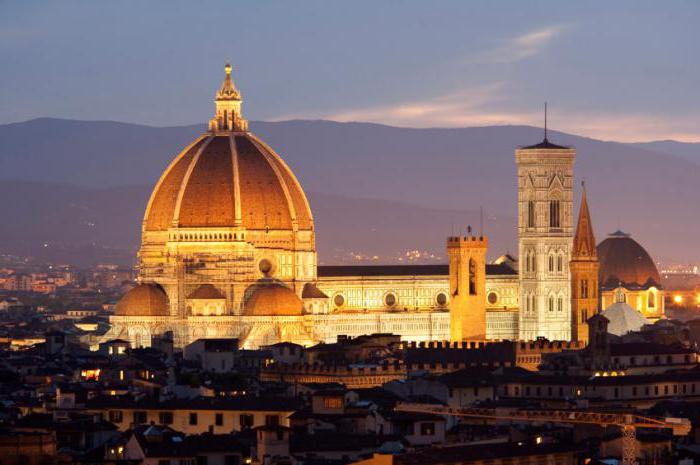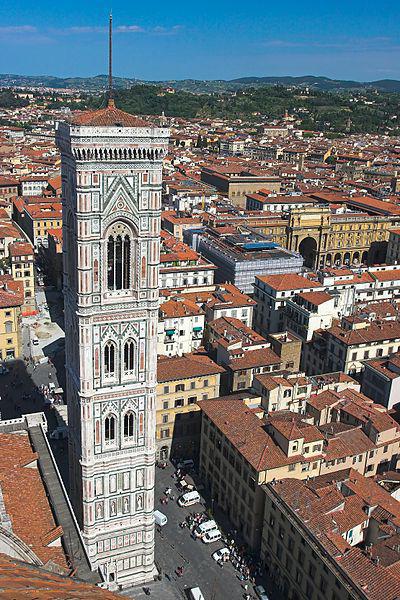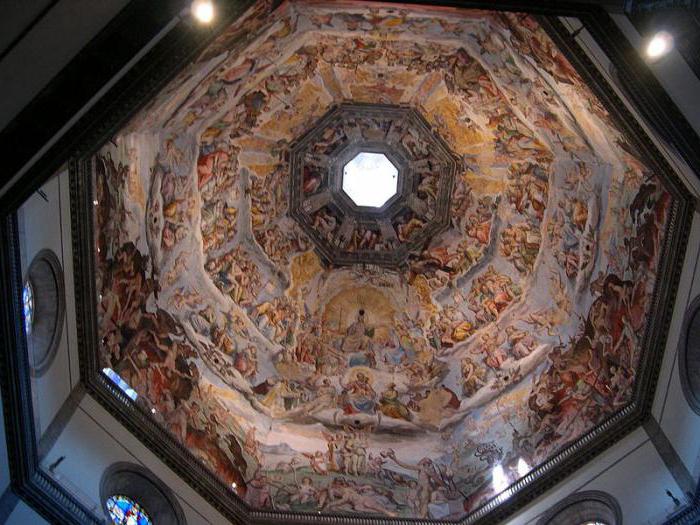The Church of Santa Maria del Fiore is one of the main attractions of Florence. This is a whole architectural ensemble, which includes the Baptistery (baptismal) and the Campanile (bell tower). The latter serves as a guide to the lost tourist, as it rises to ninety meters. And the bright red dome of Santa Maria del Fiore is the hallmark of the capital of Tuscany. Speaking of the title. There are several churches dedicated to the Mother of God in Florence. Very close to the station is Santa Maria Novella. It looks like an inlaid casket with its black and white facade. But once she inspired horror in the Florentines, as she was the church of the Dominicans and the Inquisition. But “Madonna-in-Flowers” was a meeting place for citizens, a symbol of the greatness of Florence. This is the cathedral, or, as is commonly called in Italy, the Duomo. In this article we will give the most complete information about this temple.
Historical background of construction
This was the end of the thirteenth century, when after the defeat of the Ghibellines, the power of the pope was strengthened. And in order to show the triumph of the Catholic Church over the "pataren (Albighean) heresy", huge cathedrals began to be erected. They were supposed to rise above the whole city as a symbol of the dominance of papal power. In addition, one should not forget about the feudal fragmentation that Italy experienced then. The Duomo of Florence was to “wipe the nose” of such long-time rivals of the city as Pisa and Siena. The city also needed a temple that would be able to accommodate the entire population. And Florence, huge at that time, exceeded London in the number of inhabitants. Thirty thousand people - this is the capacity of the cathedral of the capital of Tuscany. This, according to the architects, was supposed to be an indoor forum where all the townspeople of the Christian faith from small to large could gather. Of course, the amount of construction required astronomical. But Florence of the thirteenth centuries was in its prime. Wool dyeing and trade brought a steady income to the city. And therefore there was money for the construction.

History of the Duomo
The place for the construction of the cathedral was chosen already dilapidated for several centuries, the church of St. Reparata. The decision to demolish the temple built in the fourth century was made in 1289. As it is accepted now, a competition was announced, but the Florentine art guild won the tender, which commissioned its member, the architect Arnolfo di Cambio, to develop the project. The order specified that the Duomo (Florence) should become larger in size and richer decorated than the cathedrals of Siena and Pisa. The first stone in the construction was laid by the papal legate Cardinal Pietro Valeriano Duraguerra in September 1296. Arnolfo di Cambio personally supervised the work. But after the death of the master in 1302, construction stopped for twenty-eight years. Probably the lack of funds for the implementation of such a large-scale project affected. But here the forces of heaven intervened in the construction. In the basement of the old church of Santa Reparata, the relics of Zinovius of Florence were “miraculously acquired”. The news of the miracle was brought to the ears of the Christian people by the preachers, and the gifts of the pious pilgrims helped to continue the construction.

Cathedral layout
According to the project of Arnolfo di Cambio, this building should be made in the form of a Latin cross. The one-nave Santa Reparata was complemented by two more naves on the sides. At the end of them was conceived an octagonal dome. A semicircular apse and two lateral transepts completed the layout of the Duomo. Florence in 1330 appointed Giotto, the most fashionable and highly paid master of the time, as the chief architect. But the ambitious architect, instead of continuing the work of his predecessor, took up the construction of the bell tower. Giotto died in 1337, when only the first tier of the Campanilla was built. And in 1347, a black plague came to Florence, and everyone was not up to the cathedral. After the end of the epidemic, work resumed. For nearly seventy years of construction, six chief architects have been replaced. They were Francesco Talenti, Giovanni di Lapo Gini, Alberto Arnoldi, d'Ambrogio Giovanni, Neri di Fioravante and Andrea Orkanya.
Dome of the Duomo (Florence)
By 1418, the walls were completed. It only remained to lay a dome on them. But then engineering difficulties arose. The area of the proposed dome was so vast that architects feared that it would not collapse. In addition, it was not clear how to deliver building materials to a height of over ninety meters. The work was interrupted for forty years. Florence Council announced another contest. Build a dome took Filippo Brunneleschi. To stabilize the structure, a brilliant engineer installed twenty four vertical ribs and six horizontal rings on an octagonal base. Such a frame has been holding the thirty-seven-month-old dome of Santa Maria del Fiore for more than half a millennium. Everything in it is designed to the smallest detail. Even the lanterna (lantern turret) is not just an architectural decoration. It adds load to the drum of construction, makes the dome more stable.
Cathedral settings
Even before the dome of Brunneleschi was completed, the Florentine Duomo was consecrated. This happened in 1436. For this ceremony, the Roman pontiff himself, Eugene the Fourth, arrived in Florence. This gave Santa Maria del Fiore extra weight in the eyes of the laity and clergy. The magnificent building is amazing in size. The total area of the cathedral is 8300 sq.m. The temple extends one hundred and fifty-three meters long and 90 meters wide. However, the temple does not produce the impression of a massive, crushing. Thanks to the skill of the architects, he seems to soar. The walls rise forty-five meters. They are crowned by a dome with a diameter of 42 m. The total height of the temple (from the foot to the cross at the top) is one hundred and fourteen meters. But it is hard to believe that the cathedral was completely finished only in 1887.
Exterior finish
Yes, the beautiful facade that glorified the Duomo (Florence) is not the work of the masters of the trecento or renaissance quadrocento. The fact is that in the sixteenth century a real construction scandal broke out. Numerous magistrate officials tried to warm their hands at tenders. As a result, Francis I, the Grand Duke, ordered the work to decorate the facade to stop. Only in 1876 the architect and sculptor Emilio de Fabrice was allowed to take up the matter. He came up with this game of colored marble, on a palette reminiscent of the Italian flag. The designer used a stone from Prato (green), Maremma (pink) and Carrara (white). This polychrome finish highlights the cathedral. Above the lancet arches you can see frescoes reflecting the earthly life of the Virgin Mary. The main entrance is decorated with a statue of Our Lady with the baby Christ in her arms. The bas-relief is surrounded by twelve apostles. Above is openwork Gothic rosette. Next to it are visible medallions with images of prominent figures of Florence.

Interior
The Duomo inside is no less luxurious than outside. But there is also a certain contrast between the lacy pattern of the external decor and the laconicism of the interior decoration. At one time, the Dominican preacher Savanarola took care of this, who reproached the Florentines for thinking more about the external gloss than about the spiritual component of religion. But before the frescoes of the fifteenth century, located on the vault of the cathedral, the local Puritans never reached (to the delight of the descendants). These paintings depict famous Florentines - Dante Alighieri, Giotto, Nicolo da Tollentino, Giovanni Akuto and others. The main Catholic shrine of the temple, which now attracts not so many pilgrims as tourists, is the relics of Zinovy of Florence, which, as we recall, gave an incentive to the further construction of the Duomo. Another decoration of the cathedral is a watch designed in 1443 by Paolo Uccelo. The hands of this chronometer move in the opposite direction, measuring the time remaining before the Last Judgment.
Stained glass
You can not ignore the beautiful paintings on glass. Forty-four stained glass windows adorn the transepts and arches of the naves of the Cathedral of Santa Maria del Fiore. They can be viewed for hours. The topmost stained glass windows - in the dome - illustrate the acts of Christ and the life of the Madonna. And the lower pictures are devoted to the prophets of the Old and the saints of the New Testament. The dome itself, originally white (Brunneleschi believed that his brainchild is so beautiful that does not need additional decor), was painted by the artists Federico Zucchari and Giorgio Vasari at the end of the sixteenth century. This epic mural depicts the afterlife. The lower tier is the sinners of hell who cannot reach repentance. Together with the Antichrist they will be tormented forever. Above are the souls in Purgatory. And at the very top, at the dome arch, in the host of heavenly angels, you can see Jesus Christ, the Virgin Mary, the figures of the Apocalypse and saints.
Architectural complex
The Duomo (Florence) includes not one church of Santa Maria del Fiore, but several buildings. The Baptistery, named after John the Baptist, is much older than the cathedral. It existed during the time of the small church of Santa Reparata (4th century), and took on a modern look in the twelfth century. Near the fifth largest cathedral in the world stands the bell tower. Its foundation was laid by the chief architect of the Cathedral of Arnolfo di Cambio. The project was developed by Giotto. He also built the first tier of this eighty-five-meter campaign. Further, his project was implemented by Andrea Pisano, and completed the work of Francesco Talenti. Like the cathedral, the bell tower is lined with three types of valuable marble. Now anyone can climb to the observation deck at the top of the bell tower. It offers a breathtaking view of Florence and the surrounding hills. By the way, there is a similar platform on the dome of the cathedral.
Museum
There is another building in the Duomo complex. This is museum. This building, although secular, is also very remarkable. After all, it housed the workshop of Brunneleschi. In 1891, a museum was opened in this building, which must be visited. After all, the Duomo Cathedral in Florence was constantly updated. Old parts of great historical and cultural value were transferred to the museum. There you can see not only the choirs that served as the 15th-century singers, but also much of the interior of the church, the baptistery and the bell tower. The real gem of the exhibition are the layouts and drawings of the dome, created by Filippo Brunneleschi himself. A collection of sculptures that once adorned the facade and interiors of the temple is also noteworthy. Among them stands the unfinished work of Michelangelo - “Madonna mourning Christ” (Pietta).
Temple museum
Everyone can go to the Duomo Cathedral and admire the frescoes and stained-glass windows. Entrance to the church is absolutely free. Do not be alarmed by the line at the main gate, it moves very quickly. But in order to look at the dome near, as well as climb to the observation deck or go down to the crypt, where the remains of the ancient church of Santa Reparat are represented, you need to pay money. If you intend to familiarize yourself with the architectural complex of the Duomo in detail, it is better to buy a single (complex) ticket.
Visit cost and opening hours
Duomo Cathedral is open every day. But the time when tourists can get inside varies depending on the days of the week. From Monday to Wednesday, the temple is open from half past ten to five. On Thursdays and Fridays it closes at half past three, on Saturdays - at 16:45. On Sunday, Santa Maria del Fiore opens only from half past one and is open until six. Entrance to the observation deck and the museum is available from 10:30 a.m. to 7 p.m. daily, only on Saturday is it allowed until 16:40. The script with the ruins of Santa Reparata can be viewed for a modest fee of three euros. Climbing to the dome or to the observation deck of the bell tower costs 6 Є. It’s better to buy a single ticket. It costs a lot - thirty euros. But it operates the whole day after the first control and opens the doors to the museum, the baptistery, to the observation platforms of the campaign and the dome, the crypt, as well as to the cemetery nearby.